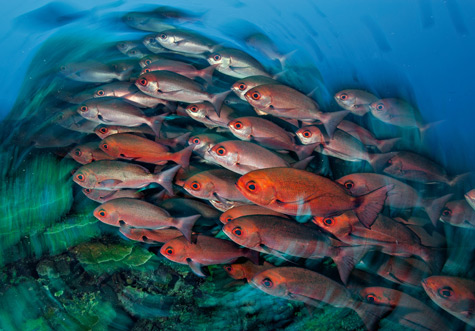Kimbe Bay Coral Reefs
Reef Madness The Pacific reef at Kimbe Bay seemed like paradise to photographer David Doubilet when he visited 17 years ago. But his recent return was more like a stop in photographic purgatory. Shooting was delayed by heavy rains and floods. Visibility was at times limited to ten feet. Several cameras became waterlogged. His wife and collaborator, Jennifer Hayes, came down with malaria. The clouds relented in spurts, allowing him to capture corals and marine life, like the school of pinjalo snappers above. The day before he left, the rain finally stopped. —Daniel Stone
Behind the Lens
 What attracted you to these pinjalo snappers?
What attracted you to these pinjalo snappers? The fish were remarkable. They would quickly change color from silver to blood orange to red as they swam by. They reminded me of a painting. I was intoxicated by their color, the way they swam, and their complete lack of fear. The school would pass by me within inches or sometimes remain very close to me. We dove this area again and again. I was addicted to these fish.
The fish were remarkable. They would quickly change color from silver to blood orange to red as they swam by. They reminded me of a painting. I was intoxicated by their color, the way they swam, and their complete lack of fear. The school would pass by me within inches or sometimes remain very close to me. We dove this area again and again. I was addicted to these fish. At one point you questioned whether to scrap the story.
At one point you questioned whether to scrap the story. I did. On a scouting dive there were dense gardens of the largest sea fans I had ever seen exploding with fish, color, and beauty. Except it was all veiled from my camera by extremely low visibility because of the rain. Everything I had come for was right in front of my eyes but nearly invisible. I was mad, panicked, and depressed. A failed assignment would have been deeply personal for me. We needed a plan B.
I did. On a scouting dive there were dense gardens of the largest sea fans I had ever seen exploding with fish, color, and beauty. Except it was all veiled from my camera by extremely low visibility because of the rain. Everything I had come for was right in front of my eyes but nearly invisible. I was mad, panicked, and depressed. A failed assignment would have been deeply personal for me. We needed a plan B. What did you do?
What did you do? We made day trips to reach deep offshore reefs within commuting distance from shore. The downsides were deeper dives and less time to shoot. The upside was the beauty we finally got to see.
We made day trips to reach deep offshore reefs within commuting distance from shore. The downsides were deeper dives and less time to shoot. The upside was the beauty we finally got to see.
Courtesy : National Geographic










Post a Comment